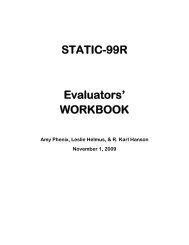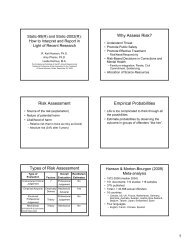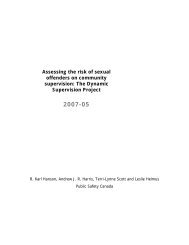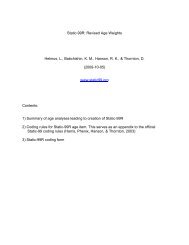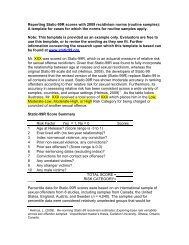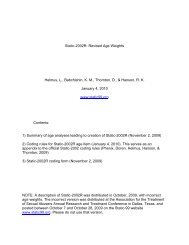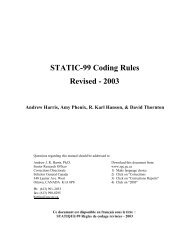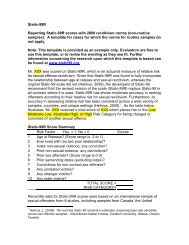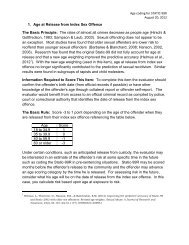Static-2002 coding rules (2009) - Static-99
Static-2002 coding rules (2009) - Static-99
Static-2002 coding rules (2009) - Static-99
You also want an ePaper? Increase the reach of your titles
YUMPU automatically turns print PDFs into web optimized ePapers that Google loves.
Category 4: Relationship to Victims<br />
8. Any Unrelated Victim<br />
Background: Research indicates that offenders who offend only against family<br />
members reoffend at a lower rate compared to those who have victims outside of<br />
their immediate family (Hanson & Bussière, 1<strong>99</strong>8; Harris & Hanson, 2004).<br />
Information Required to Score this Item: To score this item use all available<br />
credible information. “Credible Information” includes but is not limited to police<br />
reports, child welfare reports, victim impact statements or discussions with<br />
victims, collateral contacts, and offender self-report.<br />
This item is scored based on all available credible information except that<br />
specifically derived from a polygraph interview. The offender need not have been<br />
criminally charged for victims to be counted for this item.<br />
The Basic Rule: If the offender has any victim of a sexual offence outside the<br />
offender’s immediate family, score the offender a “1” on this item. If the offender’s<br />
victims of sexual offences are all within the immediate family score the offender a<br />
“0” on this item.<br />
In general, a related victim is one where the relationship is sufficiently close that<br />
marriage would normally be prohibited, such as parent, brother, sister, uncle,<br />
grandparent, stepbrother, and stepsister.<br />
A potential difficulty in scoring this item is that the law concerning who can marry<br />
differs across jurisdictions and across time periods within jurisdictions. For<br />
example, prior to 1<strong>99</strong>8, in Ontario, there were 17 relations a man could not<br />
marry, including such oddities as “nephew’s wife” and “wife’s grandmother.” In<br />
1<strong>99</strong>8 the Ontario law changed leaving only 5 categories of people that a man<br />
cannot marry: grandmother, mother, daughter, sister, and granddaughter (full,<br />
half, and adopted). Hence, if a man assaulted his niece in 1<strong>99</strong>7 he would not<br />
have an unrelated victim but if he committed the same crime in 1<strong>99</strong>8 he would<br />
technically be assaulting an unrelated victim. There is little reason to believe that<br />
this type of change in law would affect a man’s choice of victim and his resulting<br />
risk of re-offence. As a result the following <strong>rules</strong> have been adopted to avoid<br />
these jurisdictional issues.<br />
People who are Seen as Related for the Purposes of Scoring <strong>Static</strong>-<strong>2002</strong><br />
1. Legally married spouses<br />
2. Any live-in lovers of over two (essentially consecutive) year’s duration<br />
(Girlfriends/Boyfriends become related once they have lived with the offender<br />
as a lover for two consecutive years prior to the beginning of the sexual<br />
offending, with “essentially consecutive” meaning there was no interruption in<br />
their daily living together for those two years beyond business trips and other<br />
work requirements; separate vacations and/or family trips; brief jail stays; brief<br />
61



